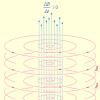In the dark, all colors are the same.
Francis Bacon
How not to get on the dark side? How not to go blind? And how, finally, sleep well and be happy? What is melanin? And how to keep it in the body? If someone is aware, do not suggest. Read the article to the end and find answers to all these questions, and not only on them! And if you know all the answers to all questions, read all the same, the repetition is the mother of the teaching. And in general, it is useful to read!
In our blog earlier, an article was published about the right choice of lamp. In that article, we described a variety of criteria for choosing a lamp, and one of them was the security criterion for health. There we wrote about ultraviolet radiation and bad mercury pairs in fluorescent lamps. Everywhere LED lamps are presented as an advanced, safe and just number one source of light. But is it so? Let's deal with.
Immediately calm you, everything is not so bad. Let's start with the pulsation. Yes, the LED lamp flies. More precisely, most often pulsates. Then there will be numbers, just throwing out physics and delve. The frequency of electric current is measured in Hertz, then Hz. In these Hz, the flicker frequency of the lamp is measured. Let's remember the standard parameters of our network with you - 220 V, 50 Hz. Regarding pulsation, the higher the figure in Hertz, the less harmful it is more accurate, less affects our brain. So, 100 Hz is the frequency of flickering of incandescent lamps and fluorescent lamps with electromagnetic chokes. The frequency of lamps equipped with an electronic driver is 300 Hz. It is worth clarifying that such flicker frequencies are not distinguishable for human eye. And the first and second frequency affect the brain quite strongly. This leads to a deterioration in the mood, decrease in performance, oppressed state. Plus, you are knocking off your biological clock and spoil the hormonal background.

The most attentive our readers have a question. You have written before that LED lamps are not pulsed. That's where everything is just in detail. The LED lamp has a driver in its design, which converts alternating current (current from the outlet) to constant. It is necessary, as I remember from past articles, for the operability of the LED. So it emits light when the direct current is passed through it. So, in low-quality lamps, it is most often worth a driver that does not convert the variable to a permanent, but generates many DC charges. As we understand from simple logic - the current is already some windy turns out, and as a result, it flies. In expensive LED lamps, ripples are minimized or absent at all. And in the dry residue it turns out that only counterfeit lamps are harmful.
Next, let's talk about two harmful moments and how to avoid them. But first things first. First you need to understand one truth - all the LEDs in the lamps, by themselves, have about the same color of the glow. Color temperature is changed by applying epoxy resin with phosphor. Again you have to remember physics. Light waves have different length. So the shortest waves are the most harmful. And they have blue and purple light. This, by the way, does not mean that the LED lamp with yellow glow is less harmful. So, these very blue and purple waves affect the retina of the eye and cause damage. There are three main types of damage. If without complex terms, then these are chemical changes in macromolecules, shock wave of light energy, damaging visual organs, heating tissues and, as a result, burn the retinal eye. There are several risk groups, or rather four, from zero to the third. Zero most secure, and the third, well, you yourself understood. And if under a lamp with a zero group, it is possible for more than ten thousand seconds, then under the third no more than 0.25 seconds. And now, they breathed deeper and stopped panic, I will tell you how not to lose sight. The main thing is that it is necessary to understand the LED low-power LED harmful in proportion to its power of a less powerful LED. So, one diode with a power of 15 watts falls into the third risk group, and with a capacity of 0.5 watts in zero. The advice is simple - take the lamps in which there are many diodes, and not one, and everything will be cool. By the way, there is another option - linased LEDs. Lens dissipates light. By the way, in general, a super option is to combine the first, and the second options.

And the last frightening point. Violation of the secretion of melatonin. Melatonin - a hormone participating in the work of the brain, normalizes the frequency of sleep and normalizes blood pressure. By the way, precisely because of the violation of the secretion of Melatonin, the head hurts those who have been sitting at the computer for a long time. Special glasses for a computer will help, they will not miss the harmful glow of the blue spectrum. So, I feel confused. Let's in order. Scientists from Israel, Italy and America investigated the effect of lamps on secretion (those who knew biology, but accidentally forgot, secretion is the development) of melatonin. As a result, they came to the fact that before bedtime a couple of hours should not be viewed on bright light sources, especially cold glow. To illuminate the bedroom to use the lamps of a warm color temperature range, and even better incandescent lamps. And then the secretion of everyone is incomprehensible there, but no less necessary hormones will not suffer.
Time to summarize. We allocate for yourself three rules, and you feel clearly, and then no light source spoils life. First - do not buy cheap LED lamps, as we do not know what they are inside. Most likely it is counterfeit, and it means that no one spent tests and cannot say what will happen to your eyes. The second - do not take lamps with one powerful diode, and we take with a lot of low-power, preferably also linked. The third is less than a computer and no bright artificial cold light before bedtime. And all of us will be cool.
The mass appearance of LED lamps on the shelves of housekeeping stores, visually reminiscent of the incandescent lamp (E14 base, E27), led to the emergence of additional issues among the population about the feasibility of their application. Advertisers declare unprecedented energy indicators, a working resource of several decades and a powerful lighting stream of innovative light sources. Research centers, in turn, put forward theories and present the facts indicating the dangers of LED lamps. How far advanced lighting technologies, and what hides the reverse side of the medal called "LED Lighting"?
What is true, and what fiction?
Several years of using LED lamps allowed scientists to make the first conclusions about their true efficacy and safety. It turned out that such bright light sources as LED lamps also have their own "dark sides". The negative was added Chinese colleagues, which, once again, flooded the market by poor-quality products. What is the lighting to give preference so that in pursuit of energy efficiency does not worsen vision? In search of a compromise solution, you will have to get closer to get acquainted with LED lamps.
In the design there are harmful substances
To make sure the ecology of the LED lamp is enough to remember from which parts it consists. Its case is made of plastic and steel base. In powerful samples around the circle there is a radiator from aluminum alloy. A printed circuit board with light-emitting diodes and radio components of the driver are fixed. Unlike energy-saving fluorescent lamps, the flask with LEDs is not sealed and not filled with gas. According to the presence of harmful substances, LED lamps can be applied in one category with most electronic devices without batteries. Safe operation is a significant plus innovative light sources.
White LED light harms vision
Going for buying LED lamps, you need to pay attention to. What it is higher, the greater the radiation intensity in the blue and blue spectrum. The retina of the eye is most sensitive to blue light, which for a long repetitive impact leads to its degradation. The cold white light for children's eye is especially harmful, the structure of which is under development.
To reduce irritation of the organs of the vision in the lamps with two and more cartridges, it is recommended to include incandescent lamps of low power (40-60 W), as well as use LED lamps emitting warm white light. The use of such lamps does not harm without high and approved by the Ministry of Health of the Russian Federation. Color temperature (TC) is indicated on the package and must be within 2700-3200 K Russian manufacturers Optogan and Svetaled recommend to acquire the lighting devices of warm tones, since their radiation spectrum is most like a sunlight.
Strongly flicker
The harm of ripples from any artificial light source has long been proven. Flickering with a frequency of 8 to 300 Hz adversely affect the nervous system. As visible and invisible pulsations penetrate through the organs of vision in the brain and contribute to the deterioration of health. LED lamps did not exception. However, not everything is so bad. If the driver's output voltage additionally passes high-quality filtering, getting rid of the variable component, then the pulsation value will not exceed 1%.  The pulsation coefficient (CP) of the lamps in which a pulsed power supply unit is built, does not exceed 10%, which satisfies the sanitary standards in force in the territory of the Russian Federation. The price of the lighting device with a high-quality driver cannot be low, and its manufacturer must be a well-known brand.
The pulsation coefficient (CP) of the lamps in which a pulsed power supply unit is built, does not exceed 10%, which satisfies the sanitary standards in force in the territory of the Russian Federation. The price of the lighting device with a high-quality driver cannot be low, and its manufacturer must be a well-known brand.
Press the secretion of melatonin
Melatonin is a hormone responsible for the frequency of sleep and regulating daily rhythm. In a healthy organism, its concentration increases with the onset of darkness and causes drowsiness. Working at night, a person is exposed to various harmful factors, including lighting. As a result of repeated research, the negative impact of LED light at night for the vision of man was proved.
Therefore, with the onset of darkness, bright LED radiation should be avoided, especially in the bedrooms. Lack of sleep after long-term viewing of the TV (monitor) with LED backlight is also due to a decrease in melatonin production. The systematic effects of the blue spectrum at night provokes insomnia. In addition to regulating sleep, melatonin neutralizes oxidative processes, which means that slows the aging.
No standards for LED lamps
This statement is partially erroneous. The fact is that LED lighting is still developing, which means it acquires new pros and cons. Individual standard does not exist for it, but it is included in a number of existing regulatory documents involving the influence of artificial lighting per person. For example, GOST R IEC 62471-2013 "Svetobiological safety of lamps and lamp systems". It describes in detail the conditions and methods of measurement of lamp parameters, including LED, formulas are given to calculate the limiting values \u200b\u200bof hazardous irradiation. According to IEC 62471-2013, all continuous wave lamps are classified by four hazard groups. The determination of a risk group for a particular type of lamps is carried out experimentally on the basis of measurements of dangerous UV and IR radiation, hazardous blue light, as well as thermal impact on the retina.
SP 52.13330.2011 Sets the regulatory requirements to all types of lighting. In the "Artificial lighting" section, LED lamps and modules are paid due attention. Their operating parameters should not go beyond the valid values \u200b\u200bprovided for by this Code of Rules. For example, clause 7.4 indicates the application as sources of artificial lighting lamps with a color temperature of 2400-6800 K and the maximum allowable UV radiation 0.03 W / m2. In addition, the value of the coefficient of ripples, illumination and light giving is normal.
Emit a lot of light in the infrared and ultraviolet range
To deal with this statement, you need to analyze the two ways to produce white light based on LEDs. The first method involves the accommodation in one body of three crystals - blue, green and red. The wavelength emitted by them does not go beyond the visible spectrum. Consequently, such LEDs do not generate light flow in the infrared and ultraviolet range.
To obtain a white light with a second way to the surface of the blue LED, a phosphor is applied, which forms a light stream with a predominant yellow spectrum. As a result of their mixing, you can get different shades of white. The presence of UV radiation in this technology is negligible and safe for humans. The intensity of IR radiation at the beginning of the long-wave range does not exceed 15%, which is incommensurable little with a similar value for the incandescent lamp. The arguments on the application of the phosphor on the ultraviolet LED instead of blue are not unnecessarily. But, while the production of white light, this method is expensive, has low efficiency and many technological problems. Therefore, before industrial scales, white lamps on UV LEDs have not yet reached.
Have harmful electromagnetic radiation
The high-frequency driver module is the most powerful source of electromagnetic radiation in the LED lamp. The pulses emitted by the RF driver can affect the work and worsen the transmitted signal of the radio receivers, WiFi transmitters located in close proximity. But harm from the electromagnetic flux of the LED lamp for a person is several orders of magnitude less harm from a mobile phone, microwave oven or WiFi router. Therefore, the effect of electromagnetic radiation from LED lamps with a pulse driver can be neglected.
Cheap Chinese healthless light bulbs
Partially the answer to this statement is already given above. Regarding Chinese LED lamps, it is customary: cheap - it means poor quality. And unfortunately, this is true. Analyzing the goods in stores, it can be noted that all LED lamps worth less than 200 rubles each have a poor-quality voltage conversion module. Inside such lamps, instead of the driver, a tangle power supply unit (BP) with a polar condenser for neutralizing the variable component is set. Because of the low capacity with the assigned function, the condenser copes only partially. As a result, the coefficient of ripples can reach up to 60%, which can adversely affect the vision and human health as a whole.  Minimize the harm from such LED lamps in two ways. The first provides for the replacement of the electrolyte on an analogue with a capacity of about 470 μF (if free space inside the case). Such lamps can be used in the corridor, toilet and other rooms with low visual stress. The second is more expensive and implies the replacement of poor-quality BP on the driver with a pulse converter. But in any case, to illuminate residential rooms and jobs, it is better to use decent, and it is better to refrain from the purchase of cheap products from China.
Minimize the harm from such LED lamps in two ways. The first provides for the replacement of the electrolyte on an analogue with a capacity of about 470 μF (if free space inside the case). Such lamps can be used in the corridor, toilet and other rooms with low visual stress. The second is more expensive and implies the replacement of poor-quality BP on the driver with a pulse converter. But in any case, to illuminate residential rooms and jobs, it is better to use decent, and it is better to refrain from the purchase of cheap products from China.
Thanks to low power consumption, energy-saving light bulbs are distributed. What harm this product makes human health, this article will help to deal.
Forms of energy-saving light bulbs
Cancer as a consequence
As scientists found out from the United States, the concentration of ultraviolet radiation, emanating from the light bulb, harms human health.
It negatively affects the skin and leads to premature dying and aging, and in the most severe cases - to melanoma and skin cancer.
Manufacturers of energy-saving light bulbs recognize that during operation there is a certain amount of ultraviolet, but it is argued that the dose of radiation is within the normal range. However, the results of studies show that the external light bulb coating has a large number of microcracks, which are the source of an increased ultraviolet.
In addition to cancerous diseases, development is possible:
- allergic rash;
- eczema;
- psoriasis;
- skin tissue.
According to the statements of medical experts, the use of energy-saving lights can cause:
- epilepsy attacks;
- migraine;
- deterioration of the tone of the body.
To date, 2 types of energy-saving light bulbs are common: collagen and fluorescent. The second species is considered the most harmful to human health.
The Israeli scientist Abraham Haim argues that the harm for luminescent lamps is significantly underestimated, especially when used at night. The fact is that energy-saving lighting leads to a violation of melatonin production due to radiation of a bluish glow, which inhibits a pinching gland and, as a result, the production of this hormone, which, in turn, increases the risk of breast cancer and prostate.
Mercury poisoning
The basis of energy-saving lamps uses a gas-filled container with a certain percentage of mercury content.
In the manufacture of light bulbs, the phosphor is used, argon gas with an admixture of mercury vapors. In disruption of the housing integrity in a closed room, the permissible value of the above harmful substances in the environment begins to exceed the permissible 20 times.

Broken lamp - a threat to health
First of all, the poison risk zone falls:
- pregnant women;
- babies;
- small children;
- old men.
Radiation
According to British specialists, in contrast to the classical incandescent bulb, energy-saving lighting, regardless of power, is a source of electromagnetic radiation.
Violation permissible norm Radiation occurs within a radius of 15 centimeters from the light source. Thus, the use of these light bulbs is not recommended in desktop and wall lamps, near which is possible to find a long time.
The electromagnetic field, the generation of which occurs at the time of operation of the light bulb, can lead to the development of the following human diseases:
- violation of Central nervous systemss;
- oppression of immune protection;
- cardiovascular diseases.
Electromagnetic waves complement the remaining adverse environmental factors and therefore are destructive for health. They are able to awaken "Sleeping" chronic diseases and reduce resistance to viral infections.
Impact on vision
Some types of light bulbs are based on LEDs are able to have a negative impact on the human visual system. This is due to the fact that the light waves of "daylight" are formed through the use of a blue and yellow diode.
The hazard for the health of visual organs represents blue radiation saturated with ultraviolet, suffers from which the retina of the eye, and, as a result, oxidative processes occur.
In the risk area are:
- Children, because They are sensitive to the effects on the eyes of energy-saving devices, due to the fact that the crystalline of the eyeball does not have an emerging crystalline (which acts as a filter), so they do not have protection against ultraviolet.
- People suffering from macular dystrophy.
- Passing medication courses of treatment.
Disposal
One bulb contains 7 milligrams of mercury. In principle, this is not much, but it is categorically prohibited to throw them into the garbage bucket. The manufacturer recommends sending energy-saving lighting lights for processing.
Functions of reception and disposal of light bulbs are theoretically lay on the district departments: Directorate for the operation of buildings (DEZ) or repair and maintenance management. But, as practice shows, energy-saving lamps fall into a landfill.
The reason for this is that if you are guided by the instructions of the manufacturer, it will be necessary to find a company specializing in mercury waste disposal and conclude an agreement. The snag is that it will have to pay, monetary compensation from the state is not provided. Given the popularity of energy-saving products and the number of light bulbs that fall into the landfill, the ecological catastrophism is the reality of the nearest future.

Special urn for non-working lamps
- When choosing a lamp, preference is recommended to be given to collagen models, they are considered less harmful to the emitted light.
- To illuminate residential premises, it is not necessary to install lamps with a capacity of more than 60 watts in the equivalent of incandescent bulbs, if the level of illumination is insufficient, it is better to use several light sources.
- It is recommended to choose lamps with a working color temperature of no more than 3100 kelvins and yellow glow. At this temperature, the emitted light stream is the most "natural" and does not have such a destructive impact on the retina and human skin.
- During installation and replacement, the lamp should be treated with it gently to avoid disruption of the integrity of the gas-filled flask. In the event that the lamp crashed, you should immediately open the windows and leave the room for several hours to remove mercury gases from the room. After conducting, remove fragments and recycle the lamp.
- When used in desktop lighting technology, the lamp is recommended at a distance of at least 15 centimeters from the permanent residence location.
Video
If you are interested in the question whether energy-saving lamps are harmful to human health, you need to learn more about their device. Such light sources are used everywhere, but the degree of impact on the body is not taken into account. So, some varieties contain mercury, while others are characterized by overestimated ripples. Benefit and harm is estimated, because the light bulbs are operated for a long period daily, so you need to be prepared for the consequences of their work.
Possible risk factors
The danger of energy-saving lamps lies as radiation, which is produced due to the design of the lighting element. Possible risk factors:
- the use of low-grade materials (in particular, the phosphor in crop and crystals in LED lamps), parts in production;
- violation of the manufacturing technological process, for example, the absence of a protective layer, which leads to an increased influence of harmful radiation.
People should be remembered that a large number of low-quality products used to illuminate the room has an intensive impact on the body.
Fluorescent Lamp
To assess the degree of negative influence of ultraviolet and other factors, it is necessary to study the structure and principle of the lighting element. Energy-saving lamps used today, identifying external sign which is a spiral-shaped flask, are called even compact or kl. This is due to the fact that their design includes an electronic driver.
In older analogs of fluorescent lamps, an electromechanical battery mechanism was used, but due to large dimensions, it was installed separately from the flask. The electronic driver in the design of such electric bulbs contributes to a decrease in the intensity of flashing. This means that the load on the organs of vision also decreases.
Principle of operation lamp CLLThe basis of the work of lamps of this species is the appearance of an electrical discharge in a gaseous medium. In the process of radiation products, a phosphor is involved, applied to the surface from the inside of the flask. The lamp is filled with mercury couples, gaseous medium (argon). When the electricity is supplied, the cathode is heated. This leads to ionization of the gas mixture, which is converted into a plasma. The result of this process is the occurrence of ultraviolet radiation. Thanks to the luminophore, visible light appears.
When using energy-saving light bulbs, several hazards are simultaneously arising: Radio frequency and ultraviolet radiation, the presence of mercury vapor under glass flasks. As a result, the negative impact of CFL on the organs of view, the skin is noted. When comparing incandescent and energy-saving analogs, it turns out that the first of the options is safer for the body.
Radio frequency radiation
All CLL lighting elements are regardless of the power and power of light are the source of electromagnetic radio frequency radiation. Given that such lamps are considered energy efficient, they do not consume electricity in large quantities. It means that the electromagnetic field is not strong enough to cause a lot of harm to the human body. However, this does not mean that they are not dangerous for life.
Energy-saving lamps based on mercury vapor can contribute to the development of various pathologies, violation of the work of the internal organs. Most often, the nervous, cardiovascular, immune system are suffering. Radio frequency radiation can be an additional negative factor that will lead to a general weakening of the body. Against the background of reduced immunity, chronic diseases are actively developing. At the same time, the organism resistance is reduced by viral infections.
 Long arrival near the energy-saving lamp can cause bad well-being
Long arrival near the energy-saving lamp can cause bad well-being The most dangerous close neighborhood with an energy-saving lamp. Radio frequency radiation is stronger at a distance of up to 15 cm. As it removes the lighting source, its effect is weakened. It means that a person who regularly operates next to the desktop lamp, in which the Lighting element Clease is installed, can feel deterioration general status organism. There is weakness, arrhythmia. However, these consequences are developing for a long period.
The further the person is from the light source, the less he is exposed to its effect. Accordingly, the negative influence can not feel in this case. The regularity of the residence within the radiation radius of these light bulbs is also important.
Harm to vision
The principle of operation of luminescent lighting elements is based on the effect of flicker. For 1 second, a multiple ignition and fuse of the glow occurs. As a result, the flicker arises, which will not be able to notice the naked eye. However, the stroboscopic effect created at the same time has an impact on organs of vision. First of all, a violation of the perception of the actual picture of the movement of the covered objects is noted. The consequence of this is a quick fatigue of organs of vision.
Despite the fact that luminescent lighting elements are called daylight lamps, they produce radiation, whose wavelength length differs from natural lighting parameters. As a result, it is perceived otherwise. In such conditions, the head hurts more often.

Opinion expert
Alexey Bartosh
Specialist in repair, maintenance of electrical equipment and industrial electronics.
Ask a question expertHowever, unpleasant symptoms occur only in the case when a person is regularly located under luminescent lighting. So, for the eye, the energy-saving compact form lamp in most cases is not hazardous, provided that it is moderately operated, i.e. for a short period and is located on the removal.
Ultraviolet radiation
To compare with other light bulbs, fluorescent analogues have a significant drawback. They produce ultraviolet rays, which in unlimited quantities can be harmful to the skin. Initially, UV radiation is produced inside the flask. Only after passing through the phosphor appears visible light.
Products that do not have a double protective layer in most cases become a source of UV-V- and UV-C-rays. They can cause skin cancer, psoriasis, alopecia, dermatitis, rash, premature aging of external covers. These types of rays have a negative impact on the organs of vision. Cataract is gradually developing if a person is regularly located in a room with such lighting.
 Sub-quality products without double protective can have a negative impact on our limits
Sub-quality products without double protective can have a negative impact on our limits Children and people with sensitive skin are stronger than other ultraviolet radiation. On them, UV rays affect the most intensive, provoking the appearance of the symptoms listed above. In addition, the use of poor quality phosphor or its gradual aging can also lead to the emergence of negative consequences. This is due to the fact that the luminescent lamp allocates more intensive ultraviolet radiation.
Additionally, the impact of ultraviolet on biochemical processes, in particular on the production of melatonin, is noted. This is a hormone that regulates the wakefulness and sleep man. Other functions: Preventing cancer cell development, maintaining immunity at a normal level. In case of violation of its development, insomnia appears, weakness, maybe, on the contrary, drowsiness.
Mercury
Clease contains 3-5 mg of this substance. It is released only with a violation of the integrity of the glass flask. If you handle the light bulb, the level of danger is significantly reduced. However, during the operation of such a product there is always a risk. For example, a lamp can be broken when it is replaced. If the integrity is violated, a significant amount of evaporation is released into the air. It is contaminated to 50 m³ of the environment. In this case, the concentration of a poisonous substance is much higher than allowed (160 times).
 If the energy-saving lamp crashed necessarily take appropriate measures
If the energy-saving lamp crashed necessarily take appropriate measures IN minimum quantities Mercury is able to cause the organism poisoning. Large dose of substance can lead to a fatal outcome. For this reason, it is important to think about the disposal of light bulbs that served their time. Use them only until the intensity of the radiation will begin to decrease. Then the light source must be replaced. Symptoms of poisoning of mercury couples:
- violation of the CNS;
- tremor;
- fever, chills;
- liver dysfunction;
- metal taste in the mouth;
- general weakness;
- bleeding gums;
- drowsiness.
LED lamp
This is a low-power, but a rather bright source of lighting. It is considered the least harmful. If you are interested in the question of which lamps are safe to use for health, you need to learn more about the device based on diodes. They contain semiconductor transducers, rectifiers, capacitors. All these elements are necessary to create suitable characteristics: low voltage, sufficiently high current strength, a substantial brightness level.
The design provides for the driver. With it, the light source is turned on. For the correction of radiation parameters is used phosphor. The layer of this material covers the LED crystals. Increased radiation intensity is due to the presence in the design of the sapphire substrate. To reduce the degree of negative impact, a heat sink is used. If the question is solved which lamps are better: LED or halogen, preference often gives the first option due to weak heating.
The principle of operation of the light source of this species is based on the interaction of semiconductors. The best LED bulbs are made from high-quality materials. Due to this, their life is extended, the lack of negative impact on the human body is noted. The flask lamps is made of polycarbonate, it is not hermetic, since there are no dangerous elements inside.
With long-term operation, there is a decrease in the lighting intensity. This is due to the natural process of crystal degradation. A shade of light may change, blue color dominates. Such changes are considered a sign of a gradual fading of LEDs. High-quality lamps degradation develops closer to the expiration of the service life declared by the manufacturer.
If low-cost lighting sources are used, they are not long served in most cases. Radiation with such parameters also has a negative impact, as well as the analogs of CLL. However, the level of harm at the same time is much smaller.
Flicker
Any light source is characterized by a stroboscopic effect. Recently it was believed that the LED bulbs do not flicker. However, this is not the case, they are at least, but "blink." The harm from this is proven by scientific research. It is believed that lamps that are characterized by a frequency in the range of 8-300 Hz have a negative impact on the nervous system.
If the LED lamp works properly, only invisible pulsations occur during its operation. However, in this case, they penetrate the brain through the organs of vision, causing harm. The degree of negative impact is extremely low. So, if the production process was not broken and the design provides high-quality filtering of the driver output voltage, the flicker value will not exceed 1%. This is a good indicator, given that according to the standards, the permissible value of this parameter is 10%.
Inexpensive light bulbs on the basis of diodes do not always correspond to the criteria. They often do not provide for the possibility of filtering the output voltage of the driver, uses a poor-quality phosphor, or the technology of applying it is broken (only on the blue crystal). Then ultraviolet radiation occurs, albeit within acceptable limits.
Violation of melatonin production
The degree of negative impact on biochemical processes in the human body is insignificant or absent. This is due to the fact that not all lamps on the basis of diodes produce ultraviolet radiation of sufficient intensity. To obtain white light, several crystals of different colors are used: red, blue, green. With such a combination, UV radiation is not produced.
In the case when the phosphor is applied with disorders or is characterized by low quality, the LED light source begins to produce ultraviolet. However, the radiation intensity does not exceed 15%, which is considered the norm. It means that the LED light bulbs affect the process of producing a hormone melatonin. If you buy products of reliable manufacturers, the probability of the appearance of negative consequences in the form of a sleep disorder is absent.
Harm white lighting
The radiation quality is determined by the color temperature. What it is higher, respectively, more harm to humans. In particular, there is a negative impact on organs of vision. In the cold white light, blue shades prevailed, and it just shows the greatest sensitivity of the retina. If under the influence of radiation of the LED lamp for a short period of time, the negative impact will be short and will not affect human health.
Staying in the radiation radiation of such a lamp for a longer period may result in the appearance of eye fatigue, retinal degradation, headache. At the same time, the impact on reflexes is, a desire appears more often to blink, since necrophore for a person. The greatest danger of such lighting causes children. This is due to the fact that the child's vision organs still continue to form, and the negative effects of cold white light can lead to the development of irreversible processes in the structure of the eye.

Uncomfortable is the lighting, characterized by the color temperature of 5000 K and higher. If the value of this parameter is within 3500-4500 K, the light is considered neutral. The warm light is characterized by a temperature of 2,700 to 3200 K. Lamps with such a range. It is recommended to use in residential premises, then your eyes will be tired less.
Precautions and ways to minimize harm
Despite some structural subtleties, it is possible to reduce the intensity of the negative impact of illumination to the human body. Energy-saving lamps are harmful to health only when low-quality products are used. It is possible to define them in appearance: the assembly is performed inactively, the materials are cheap, there are defects. In addition, the cost of such products is always lower than in the case of the analogues of common stamps. Precautions that allow minimize harm:
- if you are interested in the question, whether energy-saving light sources are harmful, it is recommended to set them away from the places of frequent people's stay indoors - under the ceiling, and it is better to use analogs of incandescent on the table;
- if a CLL or LED lamps are installed in the house everywhere, it is recommended to include them only as needed - in the dark;
- in children's rooms, the light sources of the types under consideration can not be operated;
- with a decrease in the quality of radiation, it is necessary to replace the bulbs in a timely manner;
- it is recommended to use light sources in accordance with the operating conditions, it is especially important to observe the temperature regime, control the level of humidity in the room.
When using lamps characterized by low power, the issue of safety than energy saving is more important. So, when screwing and unscrew the lighting element of a luminescent type, you can not keep it for the flask.
5 years ago, only experts heard about LED lighting. But over the past few years, the technology of mass production LED (from the English Light Emitted Diod is a light-emitting diode) made these devices available for each, because the average cost of one such lamp for home use ranges from 150-200 rubles.
Most people are prone with the joy to perceive the development of progress, while a small part is skeptical to everything new, believing that humanity is increasingly trying to hurt himself. In fact, truth, as always, somewhere in the middle. This article will carefully analyzed the benefits and damage to LED lamps, so that each end user can make a conscious choice for or against LED lighting.
The effect of LEDs on human health in comparison with other types of artificial lighting
Speaking of the influence of this type of lighting on the body, it is necessary to consider it in context with other methods for generating artificial light. As you know, now it's still quite difficult to completely replace natural lighting, so all possible approaches are only surrogates. And in this value of LED really has several advantages over lamps of other types.
Flicker
The design of most lamps for artificial lighting leads to one unpleasant effect - flicker. This is due to the use of alternating current, which leads to a rhythmic change in the brightness of the lamp with a frequency of 60 to 120 Hz. The manifestation of this effect is noticeable if you observe the light source through the video or cameras lens. This phenomenon passes by our consciousness, however, it can damage in the form of overloading visual and nervous systems, causing headache, as well as fatigue and uncomfortable feelings in the eyes. Studies held in 1989 showed that light flicker reduces the performance of an average person by 50%.

In turn, the design of most LED lamps includes a special element - a driver transforming alternating current into a constant, which deprives the lighting devices of this type of unpleasant "side effect". However, low-quality LED devices flicker just as luminescent lamps or incandescent lamps, so in this case their benefits and harm are the same.
Vibrating noise
Photographer John Ott in his work "Health and Light: The influence of natural and artificial lighting on humans and other living beings" described a negative impact on the body of a characteristic irritant sound published by fluorescent lamps. He noted that one-photon sound vibration leads to such consequences as irritability, nervousness, fast fatigue and decline in attention. LED lighting devices (like incandescent lamps) are deprived of such a shortage.
Temperature
A distinctive feature of the LED lamps is that in the process of work they are not glowing. This means that the lighting of this type is less traumatic.
Traditional fluorescent lamps, as well as compact fluorescent lamps (CLD) have in their composition of mercury pairs - extremely toxic metal, which even in small doses is dangerous for a person. Of course, several broken light bulbs will not cause any harm to human health, but production and / or disposal of these devices are associated with large risks. In addition, the culture of the disposal of such products on the household level in practice is completely absent, and exists only in theory.
In contrast, LED lighting devices do not require mercury for their production. True, their composition includes other hazardous substances, which will be discussed below.
Of all the above, it can be concluded that, according to a number of parameters, LED lighting is really safer for human health than its historical predecessors. However, in some cases, LED lamps are harmful when they are created according to the "cheap" technologies that are used by unscrupulous manufacturers.
Research negative impacts of LED lighting
The properties of each new product may have a comprehensive negative impact, so all possible aspects are studied when analyzing its safety. Most of the most dangerous to health and ecology are manufactured and / or disposal processes. But in some cases, this is especially true of the latest low-explored products, the negative impact may manifest itself during operation. In this case, the answer to the question, the LED lamps are harmful to our health, will remain open, at least for 5-10 years.
"Classic" White LED lamps
The LEDs appeared in free sale only in 1962. But massively produce home lighting devices for this technology began only since 1993, when the method of creating a white LED was opened. It consisted in passing the light of the blue LED element (which was based on India and Galia compounds) through a layer of phosphor.
It is the potential harm to the LED light sources of this type caused the greatest concern among specialists. The fact is that the Blue LED generates electromagnetic waves with a length of 460-500 nm, which is critical to the parameters of hazardous ultraviolet radiation. The greatest resonance was the experiments of the Spanish University complutunce. For his experiments, university specialists took samples of the retina of the eyes of healthy people and grown artificial fabrics. Then "artificial eyes" were subjected to light irradiation with various properties, as a result of which it was found that white LED lamps are harmful to health to the greatest extent: directly short-term (up to 100 seconds) irradiation destroys a large number of retinal cells and seriously suppresses their regeneration.
In 2014, the group of scientists also tried to answer the question of "white LED lamps for human health" are harmful and conducted similar studies that, however, were more close to real conditions. The experiment participated a group of laboratory rats, which for some time lived in a cage with a lamp suspended at such a height to imitate the top artificial lighting in a regular apartment. After 9 days of such irradiation in rats, pathological changes in the retina were found caused by the ignition of nerve cells and the slowdown in the process of their regeneration. In this experiment, various light sources were also applied, the result was confirmed by the previous theory: an increase in the wavelength of the light radiation is directly proportional to the pace of degenerative processes in the retinal tissues.
New Technology "Safe" LEDs
But in the same year, the Nobel Prize in Physics received a group of Japanese scientists who opened a new technology that allows producing white LED lamps, the harm of which is minimal. A combination of several multi-colored diodes is used as a light source, the radiation of which is mixed under the influence of a special lenses, resulting in white light, which is similar to the natural process of forming a "colorless" natural light.
Now there are three technologies for creating white LED lamps:
- Luminofor LEDs (blue or ultraviolet radiation is passed through a layer of phosphorus, the most "old", cheap and dangerous appearance.
- RGB LEDs (multichannel), invented in 2014. To obtain light, a variety of basic colors can be used.
- Hybrid LEDs - both technologies combine.
Thus, it can be concluded than less "cold" and long-wave radiation produces a LED lamp, the safer it for sight.
However, directly destroying retina light radiation is not the only danger to human health, which can represent the lighting devices of this type.
Violations of the production of sleep hormones
Recently, great attention of researchers occupies a problem of violation of the normal daily cycle of a person. This phenomenon is associated with many technogenic factors, one of which is called the impact of long-wave radiation to our hormonal system. It was found that long-wavelength radiation (most of all such harm is manifested not from LED lamps, but from a variety of LED monitors) inhibits the production of sleep hormone - melatonin, which leads to insomnia and / or serious violations of the day. Consequence of this effect that was called "digital visual syndrome" are chronic fatigue, strong impending of vision, irritability, headaches, loss of appetite and a number of other symptoms.

In case of detection of such signs, doctors recommend limiting the time of working with various gadgets generating "unhealthy" light, as well as refuse to view the TV or internet surfing through a smartphone at least an hour before the alleged waste to sleep.
Presence of harmful elements
As mentioned above, the LED lamps do not contain a dangerous mercury, but in 2010, data indicating the presence in some LED lighting devices of other substances of high degree of harmful in some LED-lighting devices of other substances is published. This time, the danger was discovered in red LEDs, which are often used in a variety of technical devices, ranging from New Year's garlands and ending with automotive headlights.
A group of scientists from the University of California under the leadership of Professor Foladeeeitan (Ogunseitan) found significant concentrations of arsenic, lead and several other hazardous substances in such lighting devices. In addition to the fact that they are known neurotoxins, with long-term exposure to the body, these components can provoke the formation of malignant tumors.

It was also discovered that some manufacturers in creating modern white LED lamps use nickel, which can cause a strong allergic reaction. And the most "safe" background in this background looks like copper, which, although it does not cause direct damage to the human body, however, can provoke a local ecological catastrophe if such devices are disposed of near rivers or lakes.
Of course, the concentration of these substances in one lamp is not dangerous for a person, but 10.50,100 broken "dirty" LEDs will most likely lead to toxic poisoning. This problem is especially relevant for road workers who often have to remove broken headlights or lades of street / road lighting.
It should be noted that in most cases such "additives" is needed only to reduce the cost of production process. Therefore, with proper legislative regulation with this negative trend, it is quite possible to fight, making economical LED lighting significantly safer.
LED technology is a truly important technological breakthrough. And, like any new discovery, it can, along with explicit advantages to hid the hidden threats. But on the basis of already existing data, it can be concluded that the safety of LED devices depends largely on the manufacturer, and the high-quality LED lamp is not much more dangerous than the traditional incandescent lamp.
Video on the topic














